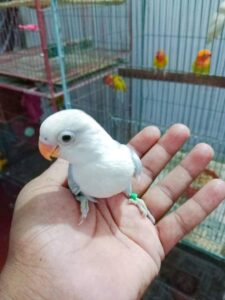Love Birds
A Comprehensive Guide to the Charming Pet Bird Lovebird
Lovebirds are one of the most adored pet birds in the world, known for their vibrant colors, affectionate nature, and playful personality. These small parrots, belonging to the genus Agapornis, have captured the hearts of bird enthusiasts for generations. In this article, we’ll delve into the captivating world of lovebirds, exploring their origins, characteristics, care requirements, diet, and why they make such delightful pets.
1. Origin and Species of Lovebirds
Lovebirds are native to Africa, with most species originating from sub-Saharan regions. There are generally nine well-known species of lovebirds, each of them have some unique characteristics:
- Fischer’s Lovebird (Agapornis fischeri): Known for their vibrant green bodies, orange faces, and blue tail feathers.
- Peach-Faced Lovebird (Agapornis roseicollis): Popular for their peach-colored faces and bright green bodies.
- Masked Lovebird (Agapornis personatus): Recognizable by their black heads and white eye rings, contrasted with bright green plumage.
- Black-Cheeked Lovebird (Agapornis nigrigenis): Identified by their dark cheek patches and bright green body.
- Liliane’s Lovebird (Agapornis lilianae): Similar to Fischer’s lovebirds but with a slightly smaller size and paler colors.
- Nyasa Lovebird (Agapornis lilianae): Often confused with Liliane’s lovebird, but with a distinct orange face.
- Black-Winged Lovebird (Agapornis taranta): The only species with significant black markings on the wings.
- Red-Faced Lovebird (Agapornis pullarius): Characterized by their red faces and green bodies.
- Grey-Headed Lovebird (Agapornis canus): Unique to Madagascar, these are smaller and have a distinctive grey head.
2. Characteristics of Lovebirds
Lovebirds are small, usually measuring around 5 to 7 inches in length, with a stout build and a short tail. Their most striking feature is their colorful plumage, which varies significantly between species. They are known for their energetic and lively behavior, often seen climbing, playing, and exploring their surroundings.
One of the most notable traits of lovebirds is their strong bond with their mates. As their name suggests, lovebirds are highly social and affectionate, often seen snuggling and grooming each other. While they are not always monogamous, they form strong pair bonds that can last for years.
3. Personality and Behavior
Lovebirds are intelligent and curious creatures, making them both entertaining and challenging as pets. They are known for their playful and sometimes mischievous behavior, often exploring every nook and cranny of their cage or environment. Lovebirds require plenty of mental stimulation to keep them happy and prevent boredom.
These birds can be quite vocal, producing a range of chirps and squawks. While they do not have the talking ability of larger parrots, lovebirds can learn to mimic simple sounds or phrases with patience and repetition.
4. Caring for Lovebirds
Proper care is essential for keeping lovebirds healthy and happy. Here are some steps of proper care:
- Cage Size and Environment: Lovebirds need a spacious cage to accommodate their active nature. A Lovebird cage size of 24 x 24 x 24 inches is perfect,horizontal bars are also needed with the cage for climbing. The cage should be equipped with perches, toys, and space for flight. Lovebirds also enjoy time outside the cage, so supervised playtime in a bird-safe room is ideal.
- Diet and Nutrition: A balanced diet is crucial for the well-being of lovebirds. Their diet should consist of high-quality pellets, supplemented with fresh fruits and vegetables like apples, carrots, spinach, and peas. Seeds can be given in moderation, as they are high in fat. Clean and freshwater should be available every day.
- Social Interaction: Lovebirds thrive on social interaction. They need daily engagement with their owners, which can include talking, playing, or simply spending time together. If keeping a single lovebird, the owner must provide plenty of interaction to compensate for the absence of a mate.
- Health and Hygiene: Regular cleaning of the cage, food dishes, and water bowls is essential to prevent the buildup of bacteria. Lovebirds also enjoy bathing, which helps keep their feathers in good condition. Providing a shallow dish of water or a mist spray can encourage bathing.
5. Common Health Issues
Lovebirds are generally hardy birds but can be susceptible to certain health problems. Common issues include:
- Psittacine Beak and Feather Disease (PBFD): A viral infection that affects the beak, feathers, and immune system.
- Respiratory Infections: Caused by bacteria, fungi, or viruses, often due to poor hygiene or drafts.
- Nutritional Deficiencies: Can result from an imbalanced diet, leading to issues like feather plucking or weakened immune responses.
- Parasites: External parasites like mites can cause skin irritation and feather damage.
Regular veterinary check-ups and prompt attention to any changes in behavior or appearance can help catch and treat these issues early.
6. Breeding Lovebirds
Breeding lovebirds can be a rewarding experience but requires commitment and knowledge. Lovebirds reach sexual maturity around 10 months of age, and breeding pairs should be provided with a nesting box filled with suitable nesting material like shredded paper or softwood chips. The female usually lays 4 to 6 eggs, which hatch after about 23 days of incubation.
Breeding lovebirds should be monitored closely to ensure they are healthy and not overbreeding, which can exhaust the female and impact the health of the chicks.
7. Why Lovebirds Make Great Pets
Lovebirds are perfect for those who have the time and dedication to meet their needs. Their small size makes them suitable for apartment living, and their vibrant personalities bring joy and entertainment. Lovebirds form strong bonds with their owners, offering affection and companionship.
However, potential owners should be prepared for their noise level, need for social interaction, and the commitment required to keep them healthy and stimulated.
8. Tips for Choosing a Lovebird
When choosing a lovebird, it’s essential to select a healthy bird from a reputable breeder or pet store. You should look for a bird which has bright eyes, clean feathers. Avoid birds that appear fluffed up, have discharge from their eyes or beak, or seem lethargic.
It’s also important to decide whether to keep a single lovebird or a pair. While pairs can keep each other company, single lovebirds often bond more closely with their owners.
9. Conclusion
Lovebirds are delightful, colorful, and affectionate companions that can bring a lot of joy to the right owner. With proper care, a balanced diet, and plenty of interaction, these small parrots can thrive and provide years of companionship. Whether you are a first-time bird owner or an experienced avian enthusiast, lovebirds are a charming choice that can light up any home.
By understanding their needs and quirks, you can ensure that your lovebird lives a happy, healthy, and fulfilling life. Embrace the joy of caring for these vibrant birds, and you’ll discover why so many people are enamored with the sweet, spirited lovebird.
